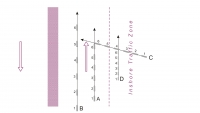-
Description of scenario:
Vessel A: power-driven vessel
Vessel B: power-driven vessel
Vessel C: power-driven vessel
Area: On the high seas
Visibility: Good (Vessels in sight of one another)
Vessel A and vessel B are sailing in approximately parallel courses and vessel B is overtaking vessel A on her starboard side
Vessel A has vessel C on her own starboard side (relative bearing STBD 035°)
Vessel A and vessel C are crossing so as to involve risk of collision
Vessel B and vessel C are crossing but there is no risk of collision -
Rule(s) to be applied:
Rule 13
(Overtaking)
Rule 15 (Crossing situation)
Rule 16 (Action by give-way vessel)
Rule 17 (Action by stand-on vessel) -
Applying the Rule(s) and comments:
Overtaking situation (vessel A and vessel B):
In accordance with Rule 13 (a) (Overtaking situation), notwithstanding anything contained in the Rules of Part B, sections I and II, any vessel overtaking (vessel B) any other vessel (vessel A) shall keep out of the way of the vessel being overtaken (Vessel A).
In accordance with Rule 13 (d) (Overtaking situation), any subsequent alteration of the bearing between the two vessels shall not make the overtaking vessel (Vessel B) a crossing vessel within the meaning of these Rules or relieve her (Vessel B) of the duty of keeping clear of the overtaken vessel (Vessel A) until she is finally past and clear.
In accordance with Rule 16 (Action by give-way vessel), every vessel (vessel B) which is directed to keep out of the way of another vessel (vessel A) shall, so far as possible, take early and substantial action to keep well clear.
In accordance with Rule 17 (a)(i) (Action by stand-on vessel), where one of two vessels is to keep out of the way the other shall keep her course and speed.
Crossing situation (vessel A and vessel C):
In accordance with Rule 15 (Crossing situation), when two power-driven vessels are crossing so as to involve risk of collision, the vessel (vessel A) which has the other (vessel C) on her own starboard side shall keep out of the way.
In accordance with Rule 15 (Crossing situation), vessel A shall, if the circumstances of the case admit, avoid crossing ahead of vessel C.
In accordance with Rule 16 (Action by give-way vessel), every vessel (vessel A) which is directed to keep out of the way of another vessel (vessel C) shall, so far as possible, take early and substantial action to keep well clear.
In accordance with Rule 17 (a)(i) (Action by stand-on vessel), where one of two vessels is to keep out of the way the other shall keep her course and speed.
Vessel A, in accordance with Rule 17 (Action by stand-on vessel) shall keep her course and speed for vessel B, but in accordance with Rule 15 (Crossing situation) vessel A shall keep out of the way of vessel C.
Comments:
In accordance with Rule 17 (a)(i) (Action by stand-on vessel), vessel C shall keep her course and speed for vessel A and vessel B.
In accordance with Rule 17 (a)(i) (Action by stand-on vessel), vessel A shall keep her course and speed for vessel B, but in accordance with Rule 15 (Crossing situation), vessel A shall keep out of the way for vessel C. - Actions: In accordance with the ordinary practice of seamen, vessels A may take the following actions to avoid collision or close-quarters situation.
- Graphics:

a) Vessel A may reduce speed to enable safe passing of vessel C
Register to get free access to bird's-eye view video (and ECDIS view video)!
- Graphics:

b) Vessel A may make 360° turn to port to avoid collision with vessel C
Register to get free access to bird's-eye view video (and ECDIS view video)!
- Graphics:

c) Vessel A may take early and substantial action by alteration her course to starboard, if such action does not result in close-quarter situation with vessel B
Register to get free access to bird's-eye view video (and ECDIS view video)!
Scenarios
Basic COLREGs Course - Visit our basic course for single rule scenarios and interpretation!
This project has been funded with support from the European Commission. This publication [communication] reflects the views only of the author, and the Commission cannot be held responsible for any use which may be made of the information contained therein.



























